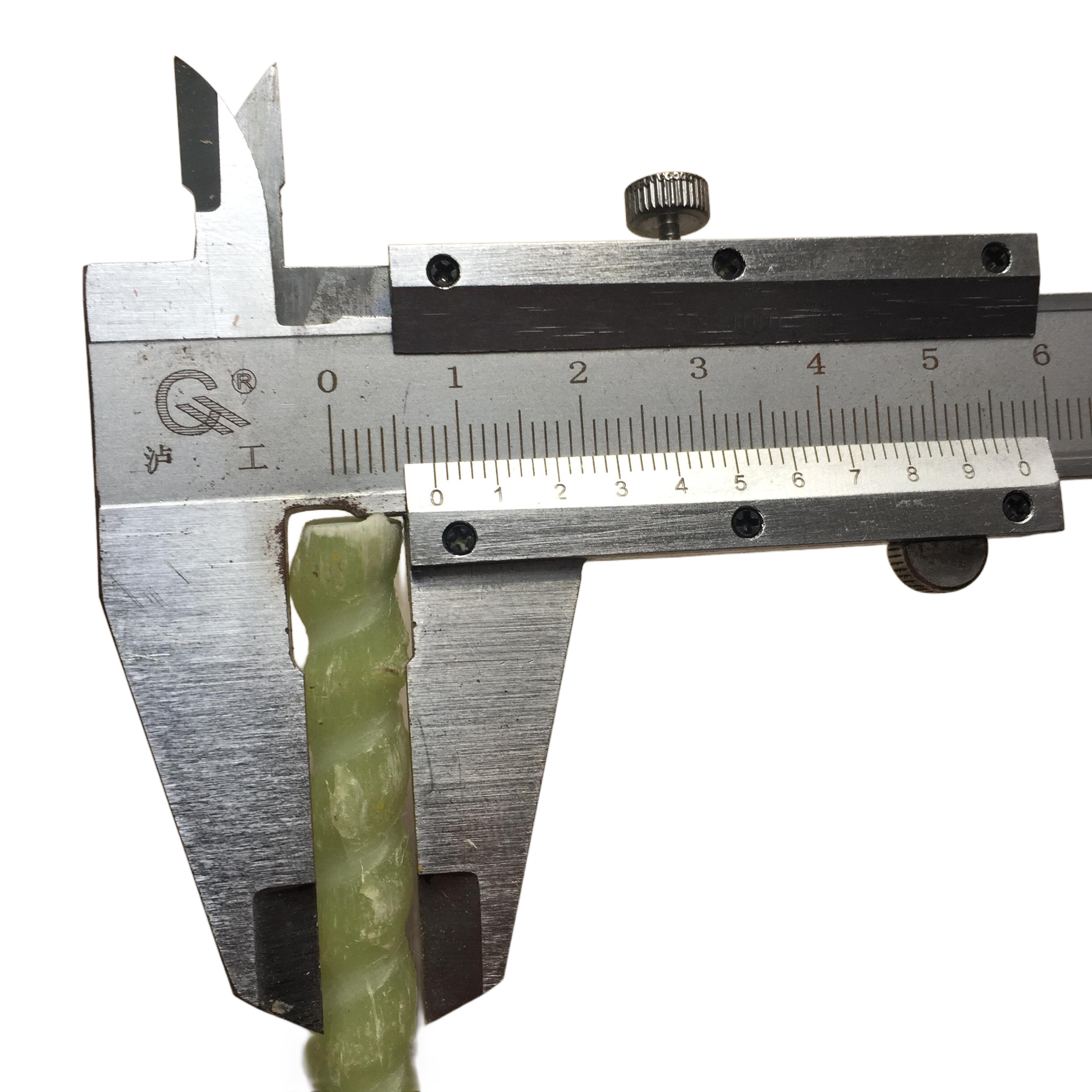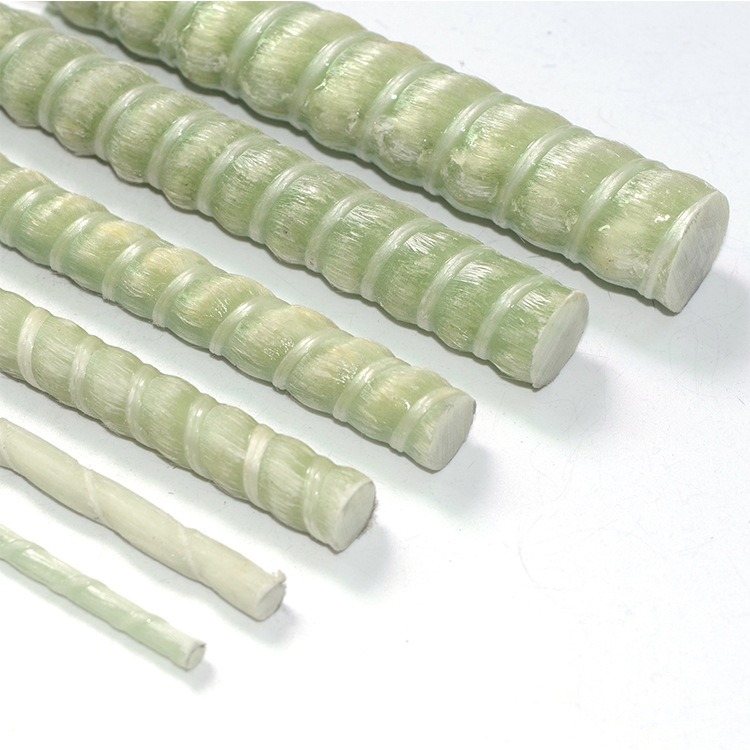Deep analysis of the advantages of glass fiber reinforced polymer (GFRP) bars (no less than 2000 words)
As a new type of composite material, glass fiber reinforced polymer (GFRP) is gradually changing the application pattern of traditional building materials due to its unique performance advantages. This article will comprehensively analyze the core advantages of GFRP reinforcement from multiple dimensions, including material nature, application fields, market trends, technical standards, and future challenges.
1、 Material essence: perfect combination of lightweight, high strength, and corrosion resistance
1. Lightweight and high-strength, breaking through the limits of traditional materials
The density of GFRP reinforcement is only 1/4 of ordinary steel bars (1.5-2.2g/cm ³), but its tensile strength can reach 500-900MPa, and some high-performance products even exceed 1000MPa, which is 1.5-2.5 times that of HRB400 reinforcement. This "lightweight and high-strength" characteristic allows GFRP reinforcement to provide higher load-bearing capacity while reducing the weight of the structure. For example, in bridge reinforcement engineering, using GFRP reinforcement instead of some steel bars can significantly reduce the self weight of the beam, reduce the load pressure on the lower structure, and thus extend the service life of the bridge.
2. Excellent corrosion resistance performance
GFRP reinforcement is composed of glass fiber and resin matrix composite, which has natural corrosion resistance properties. It can resist the corrosion of harsh chemical environments such as acid, alkali, salt, etc., and will not rust or corrode. This advantage is particularly prominent in corrosive environments such as marine engineering and chemical areas. For example, in offshore platform construction, GFRP reinforcement can resist long-term erosion from seawater, maintain structural stability and durability, and significantly reduce maintenance costs.
3. Functional diversity to meet the needs of special scenarios
GFRP reinforcement not only has excellent mechanical properties, but also has various special functions:
Non magnetic/non-conductive: suitable for places sensitive to electromagnetic interference such as nuclear power plants and medical MRI rooms.
Good thermal stability: Its coefficient of thermal expansion is close to that of concrete, which can effectively reduce the stress on the bonding surface caused by temperature changes.
Strong wave transmission performance: No demagnetization treatment required, suitable for facilities such as radar stations that require electromagnetic wave penetration.
4. Convenient construction and improved project efficiency
GFRP reinforcement can be customized in shape and length, making on-site binding simple and reducing labor intensity. At the same time, its lightweight characteristics make it easy to handle and install, especially in high-altitude operations or narrow space construction, which can significantly improve construction efficiency.
2、 Application areas: Comprehensive coverage from traditional architecture to extreme environments
1. Building reinforcement and repair
GFRP reinforcement can significantly improve the durability and load-bearing capacity of structures such as bridges and floor slabs. For example, in the restoration of historical buildings, GFRP reinforcement can provide necessary structural support without damaging the original building's appearance, achieving the dual goals of protection and reinforcement.
2. Ocean Engineering
The corrosion resistance of GFRP reinforcement has been fully utilized in marine engineering such as docks, offshore platforms, and breakwaters. It can resist the long-term erosion of seawater and salt spray corrosion, maintain the stability and durability of the structure, and significantly reduce maintenance costs.
3. Infrastructure
GFRP reinforcement provides a long-term and stable reinforcement solution in infrastructure construction such as roads, tunnels, and water conservancy projects. For example, in road reinforcement, GFRP reinforcement can reduce the risk of settlement, improve the smoothness and service life of the road surface.
4. Special Environment
The chemical corrosion resistance of GFRP reinforcement has been widely used in special environments such as chemical areas, electrolytic cells, and sewage treatment plants. It can protect the structure from corrosion by acidic, alkaline and other chemical substances, and improve the service life and safety of the equipment.
5. Green buildings
In energy-efficient and zero carbon buildings, the lightweight, high-strength, and corrosion-resistant properties of GFRP reinforcement help reduce material consumption and carbon emissions, in line with low-carbon trends and sustainable development requirements.
3、 Market Status and Development Trends: Dual Assistance of Policy Driven and Technological Innovation
1. The market size continues to grow
It is expected that by 2029, the global market size of GFRP steel reinforcement materials will reach 450 million US dollars, with a compound annual growth rate of around 11.5%. The Asia Pacific region, especially China and India, has become the fastest growing area for GFRP reinforcement demand due to the rapid development of infrastructure construction.
2. Main producers and competitive landscape
At present, the main manufacturers of GFRP reinforcement in the global market include international companies such as Mateenbar and MRG Composites, as well as domestic companies such as Sinoma Technology. These enterprises continuously promote the cost reduction and performance improvement of GFRP reinforcement through technological innovation and large-scale production.
3. Analysis of driving factors
Policy support: Governments of various countries provide policy support for green buildings and environmentally friendly materials, promoting the application of new composite materials such as GFRP reinforcement.
Cost optimization: With the improvement of production technology and the realization of large-scale production, the cost of GFRP reinforcement gradually decreases and its competitiveness continues to improve.
Performance improvement: The application of high-strength and high modulus fibers, as well as the development of high-temperature resistant resins, have expanded the application areas of GFRP reinforcement.
4. Outlook on Technological Trends
Low cost production: Developing efficient production technologies such as continuous extrusion processes to improve production efficiency and reduce costs.
Performance optimization: Improve the elastic modulus of GFRP reinforcement (target above 50GPa), and develop special performance resins such as high temperature resistance and wear resistance.
Intelligent materials: integrating intelligent components such as fiber optic sensors to achieve structural health monitoring and warning functions.
4、 Standards and specifications: Ensuring engineering quality and safety
1. Appearance and size standards
The surface of GFRP reinforcement should adopt a fully threaded design, with neat thread shape and no defects such as bubbles or cracks. Its nominal diameter range is 10-36mm, and commonly used specifications include 20mm, 22mm, 25mm, etc. The straightness deviation should be controlled within 3-5mm/m (depending on the diameter).
2. Mechanical performance requirements
Tensile strength: ≥ 500~900MPa (depending on diameter and process).
Elastic modulus: ≥ 40GPa.
Shear strength: ≥ 110MPa.
Ultimate tensile strain: ≥ 1.2%.
3. Experimental methods and testing standards
The density test shall be conducted in accordance with GB/T 1463.
The tensile performance shall comply with GB/T26743.
The shear strength shall be executed in accordance with JG/T 406.
4. Application standards and precautions
Excavation engineering: GFRP reinforcement should not be used to support beam components, and underground continuous walls are only used for temporary support.
Mixed reinforcement: When there are control requirements for deformation, the GFRP reinforcement and steel bar mixed reinforcement scheme should be prioritized.
5、 Future Prospects and Challenges: Innovation Driven and Sustainable Development
1. Intelligent buildings and structural health monitoring
With the development of IoT technology, GFRP reinforcement is expected to integrate intelligent components such as fiber optic sensors to achieve structural health monitoring and warning functions. This will greatly enhance the safety and durability of building structures.
2. Extreme environmental engineering applications
In extreme environments such as deep sea and polar regions, the corrosion resistance and lightweight properties of GFRP reinforcement will be fully utilized. For example, in the construction of deep-sea exploration platforms, GFRP reinforcement can resist long-term erosion and high-pressure environments of seawater, maintaining the stability and durability of the structure.
3. Circular Economy and Sustainable Development
Develop environmentally friendly materials such as recyclable resin matrix to enhance the sustainability of GFRP reinforcement. At the same time, promote the application of GFRP reinforcement in green and zero carbon buildings to help achieve carbon neutrality goals.
4. Cost competitiveness and market promotion
Although GFRP reinforcement has many advantages, its cost is still higher than traditional steel reinforcement. Therefore, it is necessary to further reduce the cost of GFRP reinforcement and enhance its market competitiveness through policy subsidies, large-scale production, and technological innovation.
5. Long term performance data and standard improvement
Strengthen the monitoring and data accumulation of GFRP reinforcement in practical engineering, and improve relevant standards and specifications. This will help enhance market confidence and acceptance of GFRP reinforcement, promoting its wider application.
6、 Conclusion
Glass fiber reinforced polymer (GFRP) reinforcement, as a new type of composite material, is gradually changing the application pattern of traditional building materials due to its advantages of lightweight, high strength, corrosion resistance, functional diversity, and construction convenience. With the continuous growth of policy support, technological innovation, and market demand, the application prospects of GFRP reinforcement will be even broader. However, in order to achieve widespread application and sustainable development of GFRP reinforcement, challenges such as cost, connection technology, and long-term performance data still need to be addressed. In the future, with the continuous advancement of technology and the gradual maturity of the market, GFRP reinforcement is expected to become one of the mainstream materials in the construction field, providing safer, more durable, and environmentally friendly solutions for the engineering industry.




























